
We would like to thank Scythe for providing us with a review sample of their KazeFlex 120mm Slim fans. Without their generosity, this review would not be possible.
Scythe, the heavy hitting underdog of the HSF world, has once again hit us with another surprise entry into the SFF market with their low profile 120mm fan linup. At just 17mm thick, it will be interesting to see how they compare to the competition.
Table of Contents
Packaging
The packaging is compact and straightforward. All the specifications you could ever want to see on a fan are listed in great detail on the back.
With the inclusion of a hook, these fan are ready for display at your nearest retail store.
The only fault I want to voice here is that I would prefer to see Scythe use paper for their packaging, instead of plastic.
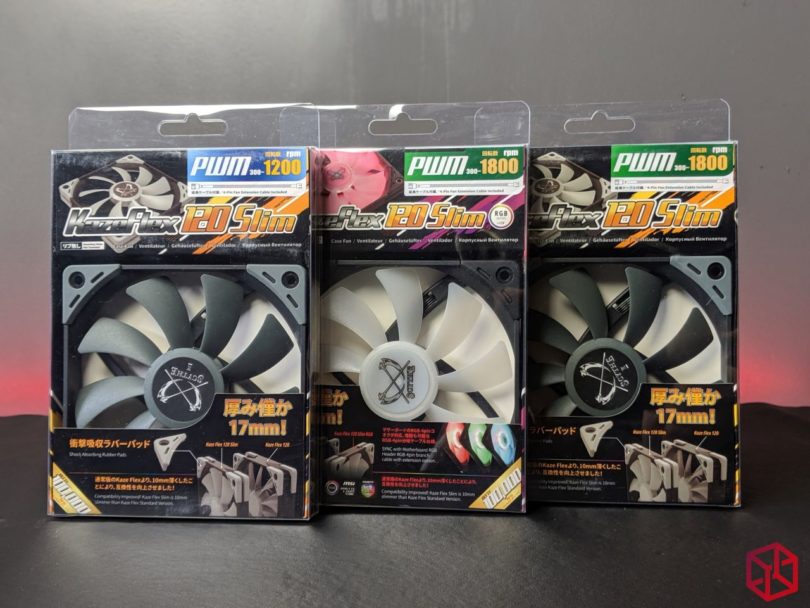
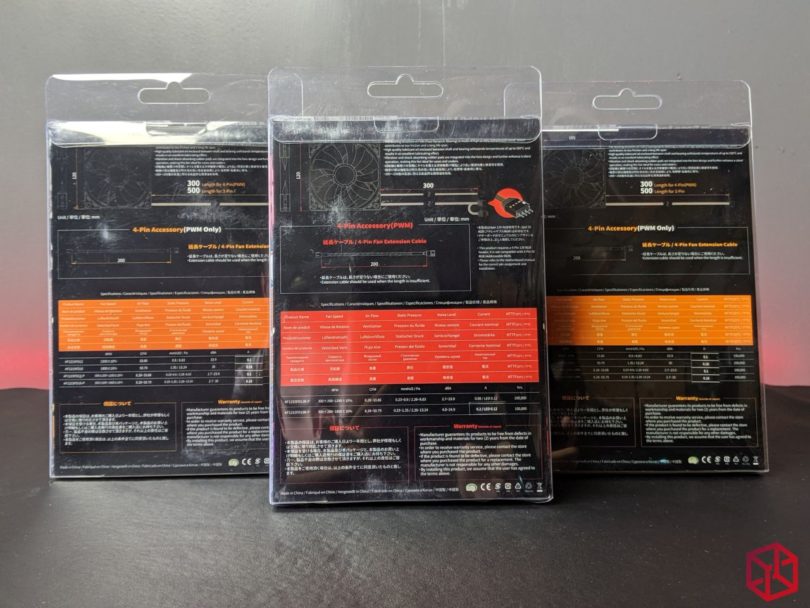
Product overview
Here are the three 120×17 mm fans sitting side by side.
On the left we have the 1200 RPM Scythe KF1215FD12-P.
In the middle we have the 1800 RPM Scythe KF1215FD18R-P
On the right we have the 1800 RPM Scythe KF1215FD18-P
All three come with a bag of 4x black mounting screws and a 20cm PWM extension cable.
The RGB fan in the middle also includes 4-PIN RGB splitter, that can used to ensure that your fan and RGB light strip(s) are getting the same signal.
The RGB fan does NOT emit light if the 4-PIN RGB header is not plugged in to an 4-pin RGB header.
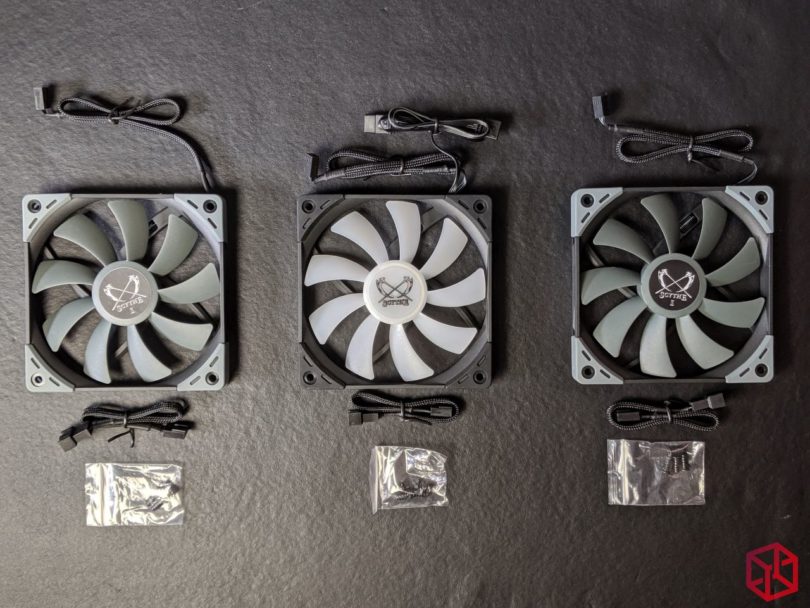
All 3 fans have the same blade profile. An interesting discovery was that the translucent plastic used for the blades on RGB fan, were noticeably more flexible than the blades on other two fans. However, that didn’t appear to make the fan sound or perform any worse in my measurements.
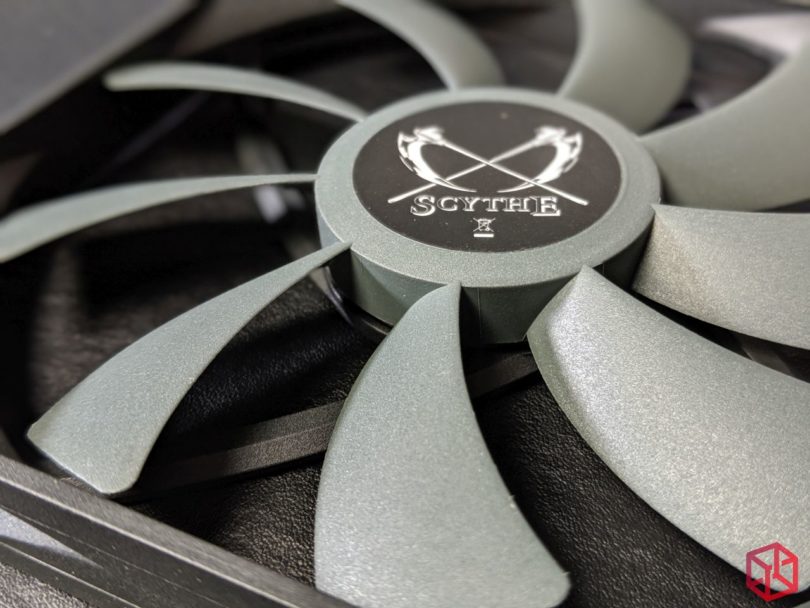
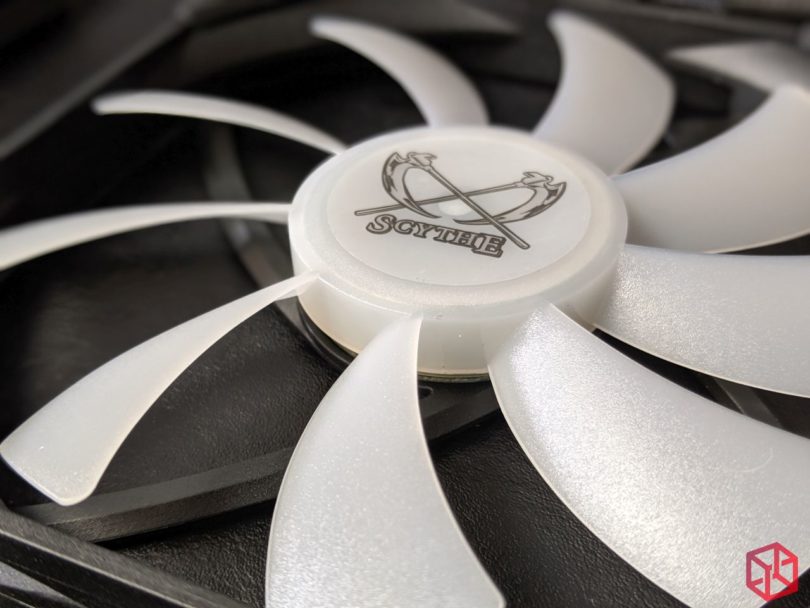
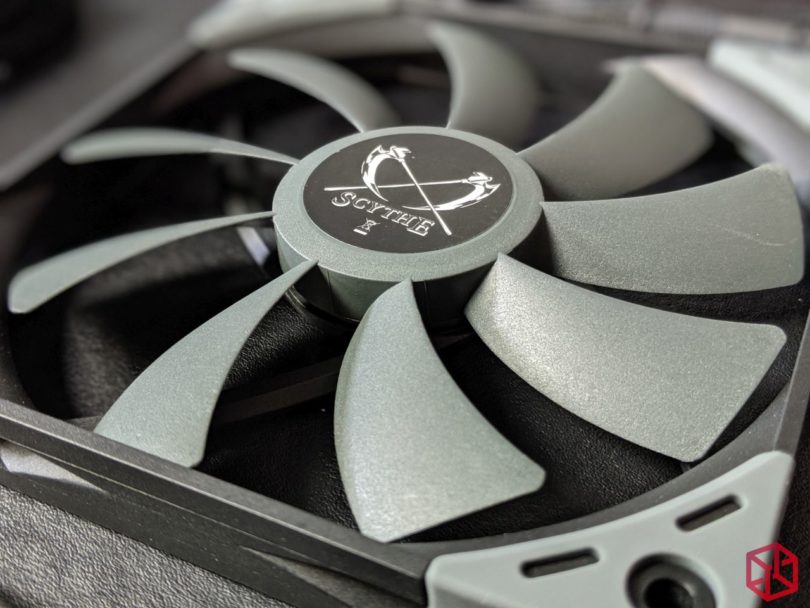
Test Setup
For this setup, we constructed our own test bench to deliver consistent results.
- The decibel value was collected using a digital sound level meter from 30″ away, with an ambient noise value of 41dB.
- The fans where set to blow away from the digital sound level meter so as not to introduce wind noise.
- Every fan was fitted with a small reflective strip to help verify the accuracy of the PWM fan controller.
- The Lamptron rheostat was adjusted to 6v, 8v, 10v, and 12.2v and with each value, the dB value and fan RPM rate, was collected.
- The Lamptron rheostat was adjusted to 750, 1000, and 1150 RPM and with each value, the dB was collected.
- To help illustrate the tone of each fan, I recorded the sound of each fan using a condenser microphone from 12″ away.
Testing equipment
AMD Ryzen 2700x
Scythe Big Shuriken 3 HSF
ASUS ROG Strix X470-I ITX motherboard (BIOS Version 2703)
NVIDIA GTX 1080 TI
G.SKILL TridentZ RGB 16GB (2 x 8GB) 3200MHz CL14
1x 500GB Samsung 960 EVO m.2 SSD
SilverStone SX800-LTI SFX-L PSU (v2 -FDB fan)
Pslatecustoms cables (1x 24-pin, 1x 8-pin, 2x PCIe 8-pin)
- Meterk 30-130dB(A) LCD Digital Sound Level Meter -used to measure the audio levels of the fan speeds at various temperatures, 30CM from the back of the PSU housing.
- HDE Professional Digital Infrared Photo Tachometer – non-contact tachometer, used to measure the fan RPM.
- Lamptron FC5 Rheostat PWM Fan controller – used to measure the output voltage to the fans.
- Coolerguys 100-240v AC 12v 4pin Molex 2A power adapter -used to power the Lamptron FC5 outside of the case.
- Audio-Technica AT2020USB+ Cardioid Condenser Microphone for capturing audio.
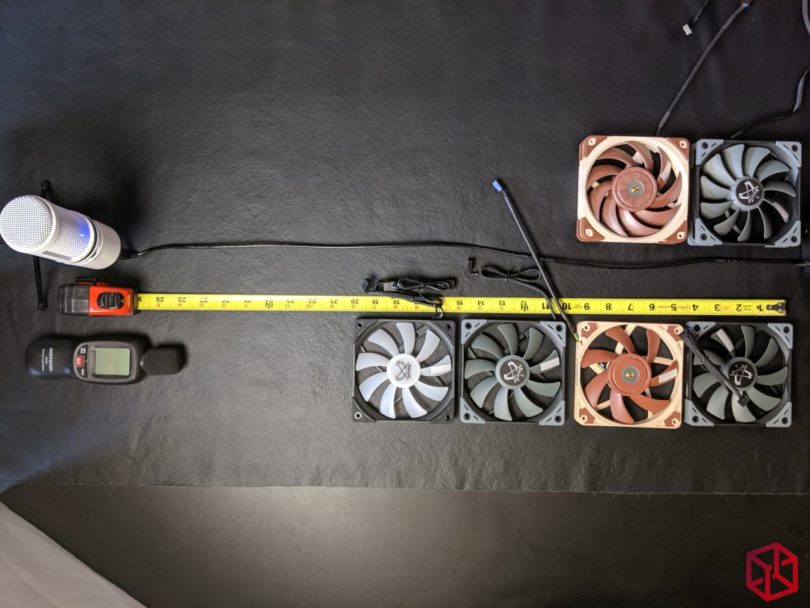
Results
Using a rheostat, I was able to determine how fast each fan spins when a certain voltage is applied.
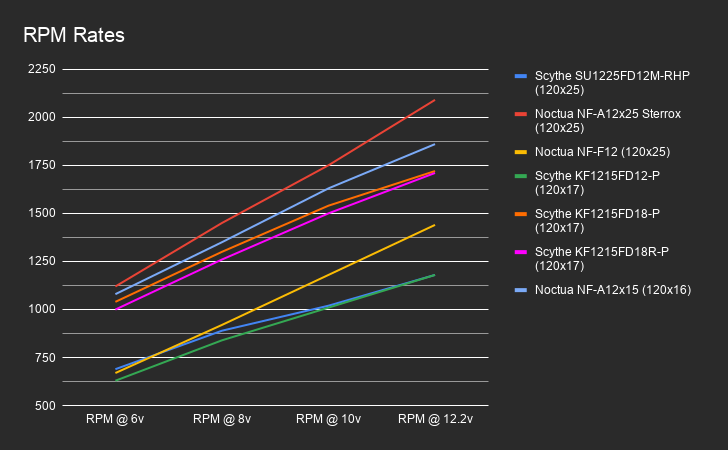
From the same capture above, we can see that all the fans fall within about 2dB of eachother from 30″ away.
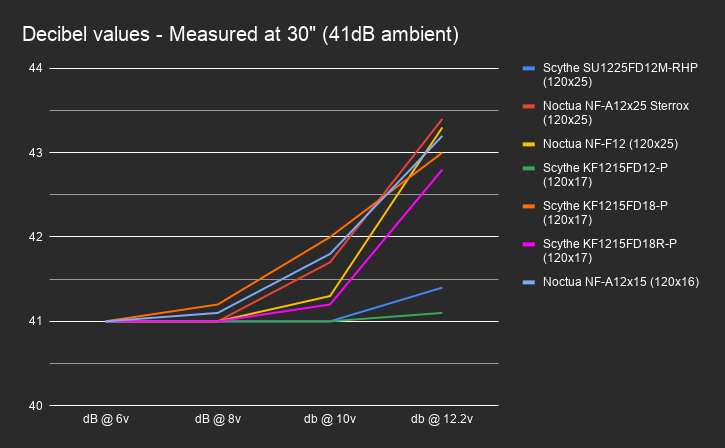
This graph analyzes how much noise each fan generated, when set to the same exact RPM rate.
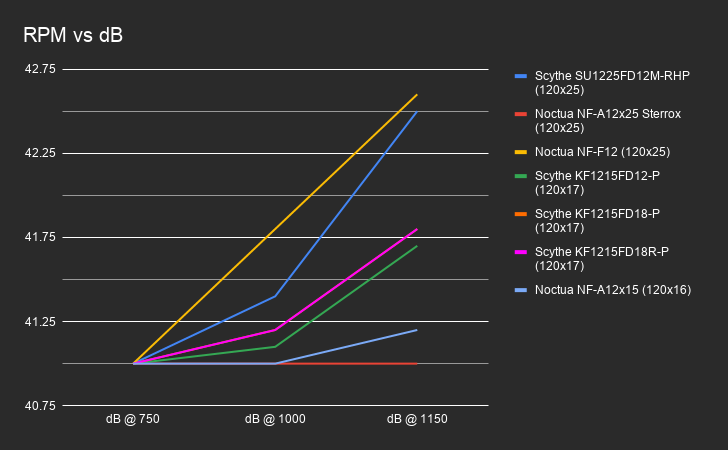
All of the data from above is better presented with real world results. Here is how every fan performed when used on the Scythe Big Shuriken 3 that we reviewed here.
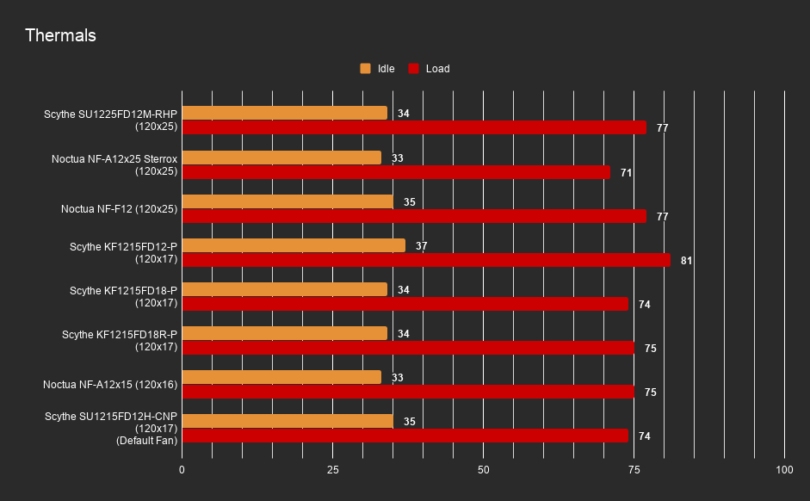
Sound
Telling you that a fan sounded quiet, or talking about tonal reverb or that pleasant whir sound we try so hard to explain can only go far.
To help you determine what fan is right for you, please take a listen to the whirs that I recorded below.
Conclusion
Scythe has proven that Noctua isn’t one of the only high-quality fan producers on the market. At almost half the price that one would pay for a Noctua fan, you can get a stellar fan from Scythe that performs nearly identical to Noctua’s offerings at almost every level. Noctua’s 120mm Sterrox fan is the clear winner in both noise and thermals but at $30 and 25mm thick, it’s a much harder sell than the $11 Scythe KF1215FD18-P at just 17mm thick.
Reading deeper into the data, Scythe’s 1800 RPM Scythe KF1215FD18-P (and RGB variant) even managed to outperform Noctua’s famed NF-A12x15 in both thermal and dB measurements, all while spinning at an even slower RPM rate. This was likely achieved by the use of 9 fan blades, over Noctua’s 7. That said, my measurements did place the Scythe fan 1mm more thick (at the corners) but it’s also not beige and brown …so there’s that.
The RGB fan performed just as well as the non-RGB Scythe KF1215FD18-P and the colors it exuded were superb when compared side-by-side with the Cryorig C7 RBG. For anyone seeking death by RGB in their SFF chassis, you now have a terrific looking fan that doesn’t skimp on performance or break the bank.
Please let us know your thoughts in the forums here!
